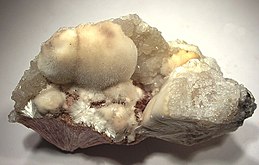
Astrophyllite is a very rare, brown to golden-yellow hydrous potassium iron titanium silicate mineral. Belonging to the astrophyllite group, astrophyllite may be classed either as an inosilicate, phyllosilicate, or an intermediate between the two. It forms an isomorphous series with kupletskite, to which it is visually identical and often intimately associated. Astrophyllite is of interest primarily to scientists and collectors.
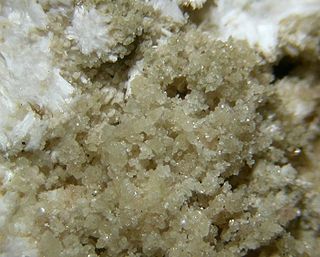
Boehmite or böhmite is an aluminium oxide hydroxide mineral, a component of the aluminium ore bauxite. It is dimorphous with diaspore. It crystallizes in the orthorhombic dipyramidal system and is typically massive in habit. It is white with tints of yellow, green, brown or red due to impurities. It has a vitreous to pearly luster, a Mohs hardness of 3 to 3.5 and a specific gravity of 3.00 to 3.07. It is colorless in thin section, optically biaxial positive with refractive indices of nα = 1.644 – 1.648, nβ = 1.654 – 1.657 and nγ = 1.661 – 1.668.
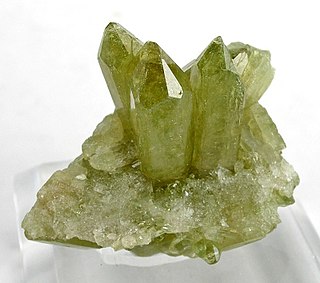
Vesuvianite, also known as idocrase, is a green, brown, yellow, or blue silicate mineral. Vesuvianite occurs as tetragonal crystals in skarn deposits and limestones that have been subjected to contact metamorphism. It was first discovered within included blocks or adjacent to lavas on Mount Vesuvius, hence its name. Attractive-looking crystals are sometimes cut as gemstones. Localities which have yielded fine crystallized specimens include Mount Vesuvius and the Ala Valley near Turin, Piedmont.

Pectolite is a white to gray mineral, NaCa2Si3O8(OH), sodium calcium hydroxide inosilicate. It crystallizes in the triclinic system typically occurring in radiated or fibrous crystalline masses. It has a Mohs hardness of 4.5 to 5 and a specific gravity of 2.7 to 2.9. The gemstone variety, larimar, is a pale to sky blue.

Afwillite is a calcium hydroxide nesosilicate mineral with formula Ca3(SiO3OH)2·2H2O. It occurs as glassy, colorless to white prismatic monoclinic crystals. Its Mohs scale hardness is between 3 and 4. It occurs as an alteration mineral in contact metamorphism of limestone. It occurs in association with apophyllite, natrolite, thaumasite, merwinite, spurrite, gehlenite, ettringite, portlandite, hillebrandite, foshagite, brucite and calcite.
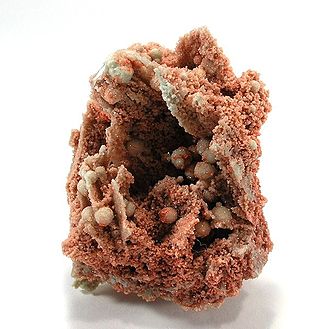
Hilgardite is a borate mineral with the chemical formula Ca2B5O9Cl·H2O. It is transparent and has vitreous luster. It is colorless to light pink with a white streak. It is rated 5 on the Mohs Scale. It crystallizes in the triclinic crystal system. Crystals occur as distorted tabular triangles and are hemimorphic, polytypes exist.

Chloritoid is a silicate mineral of metamorphic origin. It is an iron magnesium manganese alumino-silicate hydroxide with formula (Fe, Mg, Mn)
2Al
4Si
2O
10(OH)
4. It occurs as greenish grey to black platy micaceous crystals and foliated masses. Its Mohs hardness is 6.5, unusually high for a platy mineral, and it has a specific gravity of 3.52 to 3.57. It typically occurs in phyllites, schists and marbles.

Pigeonite is a mineral in the clinopyroxene subgroup of the pyroxene group. It has a general formula of (Ca,Mg,Fe)(Mg,Fe)Si2O6. The calcium cation fraction can vary from 5% to 25%, with iron and magnesium making up the rest of the cations.

Clinohedrite is a rare silicate mineral. Its chemical composition is a hydrous calcium-zinc silicate; CaZn(SiO4)·H2O. It crystallizes in the monoclinic system and typically occurs as veinlets and fracture coatings. It is commonly colorless, white to pale amethyst in color. It has perfect cleavage and the crystalline habit has a brilliant luster. It has a Mohs hardness of 5.5 and a specific gravity of 3.28–3.33.

Margarite is a calcium rich member of the mica group of the phyllosilicates with formula: CaAl2(Al2Si2)O10(OH)2. It forms white to pinkish or yellowish gray masses or thin laminae. It crystallizes in the monoclinic crystal system. It typically has a specific gravity of around 3 and a Mohs hardness of 4. It is translucent with perfect 010 cleavage and exhibits crystal twinning.

Okenite (CaSi2O5·2H2O) is a silicate mineral that is usually associated with zeolites. It most commonly is found as small white "cotton ball" formations within basalt geodes. These formations are clusters of straight, radiating, fibrous crystals that are both bendable and fragile. It also belongs to the family of the calcium silicate hydrates (C-S-H) commonly found in hardened cement paste. In cement chemist notation (CCN) it is noted as CaO·2SiO2·2H2O and abbreviated as CS2H2.

Jennite is a calcium silicate hydrate mineral of general chemical formula: Ca9Si6O18(OH)6·8H2O.

Tobermorite is a calcium silicate hydrate mineral with chemical formula: Ca5Si6O16(OH)2·4H2O or Ca5Si6(O,OH)18·5H2O.
Apachite is a copper silicate mineral with a general formula of Cu9Si10O29·11H2O. The name is associated with the Apache tribe residents of the area near the Christmas copper mine in the Dripping Spring Mountains of Gila County, Arizona, the location where apachite was first described in 1980.
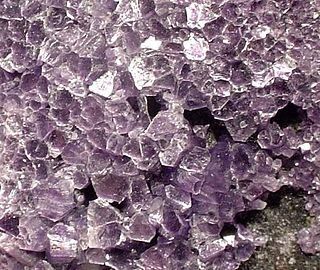
Amesite is a mineral with general formula of Mg2Al2SiO5(OH)4.

Grossite is a calcium aluminium oxide mineral with formula CaAl4O7. It is a colorless to white vitreous mineral which crystallizes in the monoclinic crystal system.

Junitoite is a mineral with formula CaZn2Si2O7·H2O. It was discovered at the Christmas mine in Christmas, Arizona, and described in 1976. The mineral is named for mineral chemist Jun Ito (1926–1978).

Scawtite is a hydrous calcium silicate mineral with carbonate, formula: Ca7(Si3O9)2CO3·2H2O. It crystallizes in the monoclinic crystal system as thin plates or flat prisms.
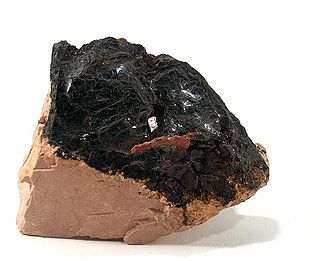
Bannisterite is a mineral named in honor of mineralogist and x-ray crystallographer Dr. Frederick Allen Bannister (1901-1970). It is a calcium-dominant member of the ganophyllite group, and was previously identified as ganophyllite in 1936, but otherwise it is structurally related to the stilpnomelane group. It was approved by the IMA in 1967.
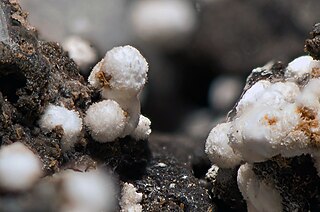
Tacharanite is a calcium aluminium silicate hydrate (C-A-S-H) mineral of general chemical formula Ca12Al2Si18O33(OH)36 with some resemblance to the calcium silicate hydrate (C-S-H) mineral tobermorite. It is often found in mineral assemblage with zeolites and other hydrated calcium silicates.
